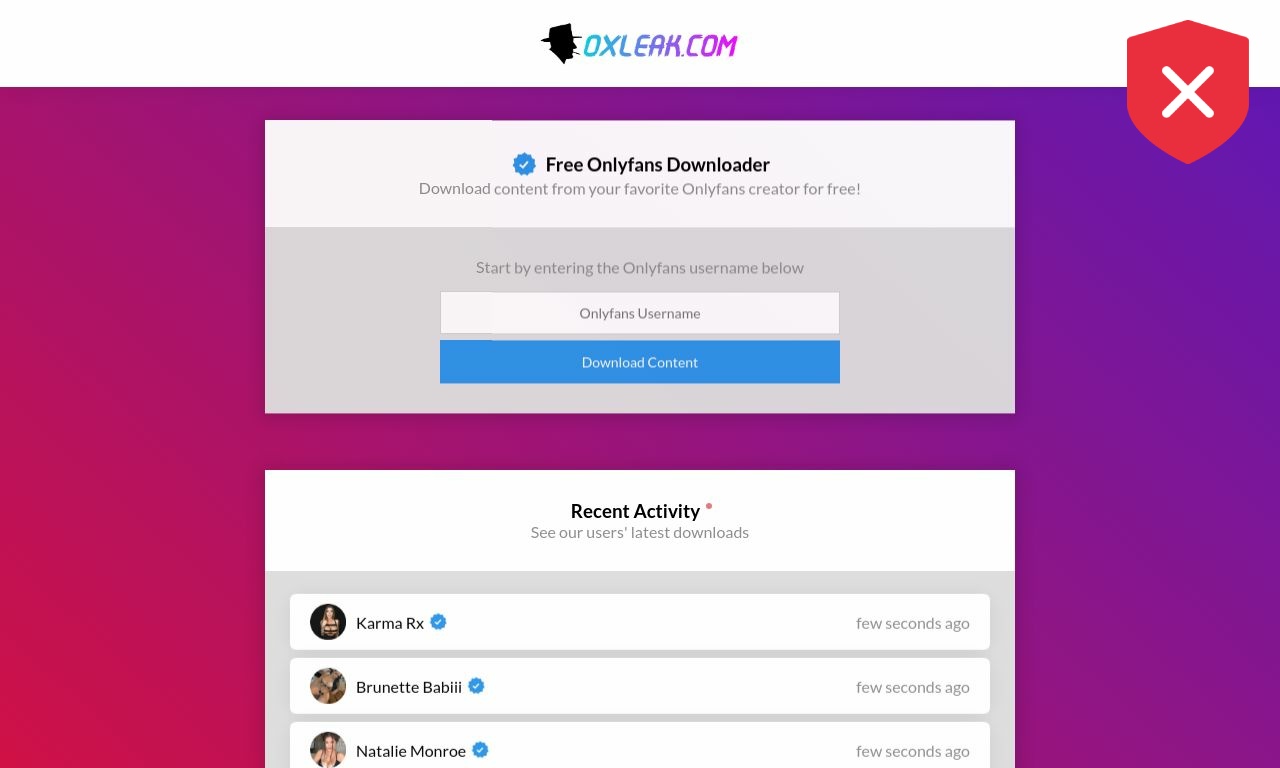Oxleak.com: Scam Or Legit? Share Your Experience & Stay Safe!
Have you ever wondered if the website you're browsing is truly safe, or just a cleverly disguised trap waiting to steal your personal information? The alarming truth is that countless websites are designed with malicious intent, and oxleak.com is raising serious red flags.
In an era where online security threats are becoming increasingly sophisticated, it's crucial to be vigilant. The term "oxleak" might not be in your everyday vocabulary, but it represents a concept that's rapidly gaining traction in the cybersecurity world. Think of it as a modern-day term to describe how sensitive data can spill online due to errors, hacks, or blatant disregard for privacy protocols. The digital landscape is littered with examples of websites that appear legitimate but are, in reality, elaborate scams designed to trick unsuspecting users. Oxleak.com is one such site that warrants close scrutiny.
Several factors contribute to the growing suspicion surrounding oxleak.com. For starters, the website has been flagged by numerous online directories and has earned a "suspicious" tag, suggesting it might be involved in malicious activities. Furthermore, recent observations have revealed that hostnames associated with oxleak.com are actively searching for newly observed domains and hostnames, a practice often associated with phishing and other illicit schemes. These observations, gleaned from certificate transparency (CT) logs, are irrevocably public, casting a long shadow of doubt over the site's intentions.
| Category | Details |
|---|---|
| Domain Name | Oxleak.com |
| Observed Behavior | Searching for newly observed domains and hostnames. |
| Blacklist Status | Flagged by online directories as suspicious. |
| Trust Score | Very low, indicating a high likelihood of being a scam. |
| Social Media Activity | Slightly inactive, raising further concerns about legitimacy. |
| Alexa Rank | Not yet estimated, suggesting low traffic and visibility. |
| Potential Threats | Malware, phishing, fraud, scam, and spam activity. |
| User Reviews | Strongly negative, with reports of deceptive practices. |
| Deceptive Tactics | Promoting fake products, services, or investment opportunities. |
| Child Safety Concerns | Detected with a negative reputation due to child safety issues. |
Numerous reports and user reviews paint a grim picture of oxleak.com. Many users have voiced concerns that the site is a scam, designed to pilfer personal information or money. The site often lures victims by promoting fake products, services, or investment opportunities, relying on false claims and testimonials to create an illusion of trustworthiness. However, beneath the surface lies a web of deceit. Independent analyses consistently reveal that oxleak.com employs various tactics to deceive visitors, mirroring the strategies used by countless other fraudulent websites.
Consider, for example, the experiences shared by individuals on platforms like Scamdoc. Users have reported a range of issues, from encountering dubious offers to suspecting outright fraud. These accounts, coupled with the site's low trust score, serve as a stark warning to anyone considering interacting with oxleak.com. The consensus is clear: proceed with extreme caution or, better yet, avoid the site altogether.
The low trust score assigned to oxleak.com is a critical indicator of potential danger. Trust scores are calculated by algorithms that analyze various factors, including ownership details, location, website popularity, and user reviews. In the case of oxleak.com, the consistently low score reflects the numerous red flags associated with the site. It suggests a significant likelihood that the website is operating as a scam, preying on unsuspecting individuals.
Furthermore, oxleak.com's presence on social media is minimal, which is unusual for legitimate businesses. In today's digital age, most reputable companies actively engage with their customers on platforms like Facebook, Twitter, and Instagram. The lack of a robust social media presence raises questions about the site's authenticity and commitment to transparency. While inactivity alone doesn't automatically signify malicious intent, it adds another layer of suspicion to the already concerning profile of oxleak.com.
It's important to remember that websites like oxleak.com often exploit vulnerabilities in human psychology. They use persuasive language, attractive offers, and carefully crafted narratives to manipulate visitors into divulging sensitive information or making unwise financial decisions. By understanding these tactics, individuals can better protect themselves from falling victim to online scams.
One common tactic employed by fraudulent websites is the creation of a false sense of urgency. For example, a site might claim that a limited-time offer is about to expire or that a product is in high demand, pressuring visitors to make hasty decisions without conducting proper research. Another tactic involves the use of fake testimonials or endorsements from seemingly credible sources. These fabricated endorsements are designed to build trust and convince visitors that the website is legitimate, even when it's not.
Moreover, many scam websites mimic the look and feel of well-known brands or organizations. They use similar logos, color schemes, and website layouts to confuse visitors and create the impression that they are dealing with a reputable entity. This tactic, known as "brandjacking," is particularly effective at tricking individuals who are unfamiliar with the genuine website or brand.
Protecting yourself from online scams requires a multi-faceted approach. First and foremost, it's essential to exercise caution when encountering unfamiliar websites or offers that seem too good to be true. Before providing any personal information or making any purchases, take the time to thoroughly research the website and its operators. Look for reviews from other users, check the site's contact information, and verify its registration details.
Another crucial step is to use strong, unique passwords for all of your online accounts. Avoid using easily guessable passwords, such as your name, birthday, or pet's name. Instead, opt for a combination of upper and lowercase letters, numbers, and symbols. Consider using a password manager to securely store and manage your passwords.
It's also important to keep your computer and mobile devices up to date with the latest security patches and software updates. These updates often include fixes for vulnerabilities that could be exploited by hackers and malware. By installing updates promptly, you can reduce your risk of falling victim to online threats.
In addition to these precautions, consider installing a reputable antivirus program and a firewall on your computer. These security tools can help detect and block malware, phishing attempts, and other online threats. Be sure to keep your antivirus program up to date with the latest virus definitions to ensure that it can effectively protect your system.
Finally, be wary of clicking on links or opening attachments in emails from unknown senders. Phishing emails are often used to trick individuals into providing personal information or downloading malware. If you receive an email that seems suspicious, delete it immediately without clicking on any links or opening any attachments.
The issue of "oxleak," or sensitive information being exposed online, extends beyond individual websites like oxleak.com. It's a systemic problem that affects organizations of all sizes and industries. Data breaches, hacking incidents, and accidental disclosures can all lead to the leakage of personal and confidential information, with potentially devastating consequences.
Organizations have a responsibility to protect the data entrusted to them by customers, employees, and partners. This requires implementing robust security measures, including data encryption, access controls, and regular security audits. It also requires training employees on cybersecurity best practices and raising awareness about the risks of phishing, social engineering, and other online threats.
In addition to technical safeguards, organizations should also develop and implement comprehensive data breach response plans. These plans should outline the steps to be taken in the event of a data breach, including identifying the scope of the breach, notifying affected individuals, and taking steps to prevent future breaches.
The rise of "oxleak" and other cybersecurity threats underscores the importance of ongoing vigilance and proactive security measures. Individuals and organizations alike must remain vigilant in protecting their personal and confidential information from falling into the wrong hands. By adopting a layered approach to security, individuals can significantly reduce their risk of becoming victims of online scams and data breaches.
The digital realm offers incredible opportunities, but it also presents significant risks. By staying informed, exercising caution, and implementing robust security measures, individuals and organizations can navigate the online world safely and securely.
Ultimately, the responsibility for online safety rests with each and every one of us. By taking proactive steps to protect our personal information and being vigilant about potential threats, we can create a safer and more secure online environment for everyone.
The information obtained from certificate transparency (CT) logs provides valuable insights into domain registration and security practices, which can be essential for detecting potential threats and fraudulent activities. These logs, irrevocably published as part of the public record, offer a transparent view of the certificates issued for websites. Analyzing these logs can help identify suspicious patterns or irregularities that might indicate malicious intent.
Furthermore, platforms like urlscan.io offer tools that enable users to observe hostnames and domains, providing a real-time view of their online activities. This capability is particularly useful for tracking newly observed domains and identifying potential phishing campaigns or malware distribution networks. By leveraging these tools, cybersecurity professionals can proactively detect and mitigate threats before they cause significant harm.
It's also crucial to consider the role of online directories and blacklists in identifying potentially harmful websites. These directories aggregate information from various sources, including user reports, security scans, and threat intelligence feeds, to identify websites that are engaged in malicious activities. When a website like oxleak.com is flagged by these directories, it serves as a strong warning sign to users to exercise caution.
Trustedsite offers a certification program for online businesses, aiming to help shoppers identify secure sites that demonstrate good business practices. This certification process involves a thorough evaluation of a website's security measures, privacy policies, and business practices. Websites that earn the Trustedsite certification are more likely to be trustworthy and reliable, providing shoppers with added confidence when making online purchases.
In addition to the technical aspects of online security, it's essential to consider the human element. Social engineering attacks, which rely on manipulating individuals into divulging sensitive information or performing actions that compromise security, are becoming increasingly sophisticated. Users must be aware of these tactics and exercise caution when interacting with unfamiliar emails, websites, or phone calls.
Cybersecurity is an ongoing battle, and the threats are constantly evolving. By staying informed about the latest threats and implementing proactive security measures, individuals and organizations can better protect themselves from becoming victims of online scams and data breaches. The fight for online security requires a collective effort, with individuals, organizations, and governments working together to create a safer and more secure digital world.
Remember, it is always better to be safe than sorry. When in doubt, err on the side of caution and avoid interacting with websites or offers that seem too good to be true. Your personal information and financial security are worth protecting.
The phrase, "This is the main channel please follow this channel to get update's" could be a telltale sign. Often these sorts of directives come from sources that are looking to push content in an attempt to draw eyes, and potentially, nefarious behaviors could begin. The most trustworthy sites ensure that their content is authentic and they aren't looking to grab an audience from an obscure platform.
As a reminder, don't hesitate to share your experiences in the comments below to help the community.



Detail Author:
- Name : Emma Walsh DDS
- Email : larson.kayden@schiller.biz
- Birthdate : 2004-03-28
- Address : 6747 Russ Flats New Dudley, KY 36721
- Phone : +19563101274
- Company : Auer-Lang
- Job : Agricultural Technician
- Bio : Consequatur sint doloremque praesentium accusamus explicabo eaque. Minima exercitationem quibusdam reprehenderit praesentium aut veritatis. Quod ipsam iste aspernatur est molestiae.